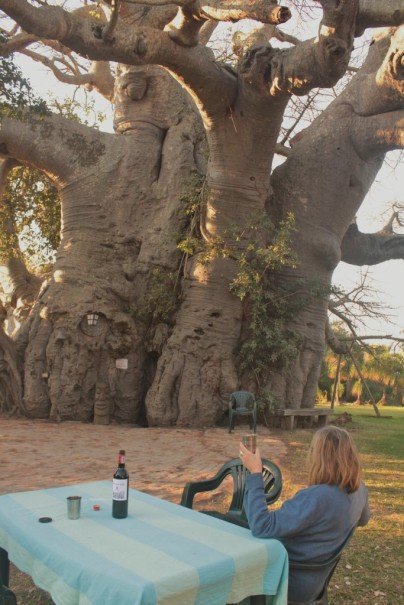
The Bar in the Belly of the World’s Largest Baobab

The Bar in the Belly of the World’s Largest Baobab
Whisky and Wine in Modjadjiskloof
“Welcome to the very big tree,” says Mama Maria, the gatekeeper as we arrive for sundowners at the world’s oldest, widest baobab tree. We’d bumped down a dusty, dirt track after dodging potholes on our drive through the small, collapsed town of Modjadjiskloof in Limpopo province in northern South Africa. It’s a plainly poor but magical area, home to rolling, blue-green mountains and the legend of the ancient Rain Queen Modjadji, who settled here four centuries ago with her rainmaking powers.
Mama Maria has smiley eyes and is wearing a housemaid’s uniform. She insists we write in the visitors’ book after we have paid our R20 entrance fee to see the Sunland Baobab, as it is known, named after the farm on which it lives. “Excellent,” wrote the person who had visited before us. But most people left the comments column blank. It’s hard to find words to describe this 75-feet tall and 150-feet wide tree that rises up out of the dry bushveld in a most outlandish way. What was excellent, however, was that a kind local had warned us beforehand that they only serve cold drinks and beer there, so we’d discreetly brought along our own picnic basket with red wine for Ruth and whisky for me. We thought a drink at the world’s oldest, widest baobab deserved something with more gravitas than beer.
We set up camp at one of the scruffy plastic tables alongside the tree and considered this surreal specimen. The Sunland Baobab is estimated to be between 1,700 and 6,000 years old, depending on the amount of alcohol the teller has consumed. The essential experience here is climbing into the bar inside the tree’s hollow trunk (baobabs trunks get hollow when they are about a thousand years old), but the bar was really only a laminated pine counter with the odd drinking accessory, some dusty military memorabilia, and the words beer spelt out in brass letters on the wall. A dank smell wafted from a milky liquid dripping from a gash in the tree trunk into a plastic bucket.
We returned to our table feeling somewhat sorry for the tree. A couple of thousand years gets you a bar in your tummy. In one place outside, the tree’s aging limbs are being propped up by telephone poles and there’s a faintly derelict air to the whole set up: a few dead potted plants, a tired collection of old railway paraphernalia, a leaning postbox in front of the entrance. Word on the street is that the Sunland Baobab farm owners are disheartened because their tree was passed up in a municipal tender for tourism development funding in favor of a new hotel next door, owned by one of the African National Congress (ANC) ruling party elite in the province. It’s especially galling since the baobab tree is the local tourism icon. We sigh and pour ourselves another drink as the sun slips down the sky.
“Ah, but wisdom is like a baobab tree,” says Ruth, quoting an old African proverb. “No one individual can embrace it.”